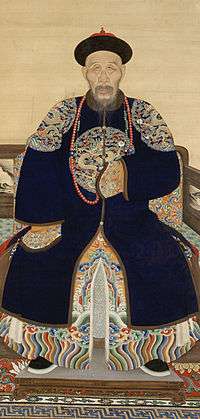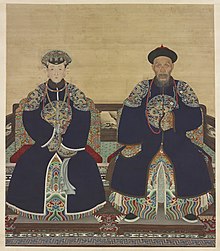Yunti, Prince Xun
Yunti (10 February 1688 – 16 February 1755), born Yinzhen and also known as Yinti before 1722, formally known as Prince Xun, was a Manchu prince and military general of the Qing dynasty.
| Yunti | |||||||||
|---|---|---|---|---|---|---|---|---|---|
| Prince Xun of the Second Rank | |||||||||
 Portrait of Yunti | |||||||||
| Prince Xun of the Second Rank | |||||||||
| Tenure | 1748–1755 | ||||||||
| Successor | Hongming | ||||||||
| Born | Aisin Gioro Yinzhen (愛新覺羅 胤禎) 10 February 1688 Beijing, China | ||||||||
| Died | 16 February 1755 (aged 67) Beijing, China | ||||||||
| Consorts | Lady Wanyan | ||||||||
| Issue | Hongchun Hongming Hongying Hongkai Princess of the Third Rank Lady of the Second Rank Lady of the Second Rank Princess of the Third Rank Princess of the Fourth Rank | ||||||||
| |||||||||
| House | Aisin Gioro | ||||||||
| Father | Kangxi Emperor | ||||||||
| Mother | Empress Xiaogongren | ||||||||
| Yunti, Prince Xun | |||||||||
|---|---|---|---|---|---|---|---|---|---|
| Chinese | 允禵 | ||||||||
| |||||||||
| Yinti | |||||||||
| Chinese | 胤禵 | ||||||||
| |||||||||
Life
Kangxi era
Yunti was born "Yinzhen" (胤祯; 胤禎; Yìnzhēn) in the Aisin Gioro clan as the 14th son of the Kangxi Emperor. His mother was Empress Xiaogongren, who also bore the Yongzheng Emperor. As Yunti's birth name "Yinzhen" was similar to that of his fourth brother, Yinzhen (胤禛), it was changed to "Yinti" (胤禵).
In 1709, Yinti was granted the title of a beizi. In 1718, after Dzungar forces defeated a Qing army along the Salween River in Tibet, the Kangxi Emperor appointed Yinti as "Great General Who Pacifies the Frontier" (撫遠大將軍) to lead an army of 300,000 into Tibet to attack the Dzungars and their leader, Tsewang Rabtan. It was believed that this was a sign that the Kangxi Emperor was considering Yinti as a potential heir to his throne. In February 1720, Yinti ordered his deputies Galbi and Yanxin to set out from Xining to take Lhasa, while he remained in Xining to build up support with their Mongol allies and then escort the Seventh Dalai Lama to Lhasa. On 24 September 1720, Yinti's army captured Lhasa and returned the Dalai Lama to the Potala Palace.
Yongzheng era
On 21 December 1722, just as Yinti was planning for a conquest of the Dzungar Khanate, he received news of the Kangxi Emperor's death and was immediately summoned back to the capital, Beijing, to attend his father's funeral. His fourth brother, Yinzhen, succeeded their father and became historically known as the Yongzheng Emperor. Yinti and his brothers had to change the character Yin (胤) in their names to Yun (允) to avoid naming taboo, because the reigning emperor's personal name contained the character Yin.
In 1723, Yunti was promoted from beizi to junwang (second-rank prince). However, in the following year, he was demoted back to beizi. The Yongzheng Emperor perceived Yunti as a potential threat to his throne, so he stripped Yunti of his beizi title in 1725 and placed him under house arrest at Shouhuang Palace, in the present-day Jingshan Park.
Qianlong era
In 1735, the Yongzheng Emperor died and was succeeded by his fourth son Hongli, who became historically known as the Qianlong Emperor. The Qianlong Emperor released Yunti in the same year after his coronation. In 1737, Yunti was restored to the ranks of nobility as a fuguo gong (a lesser duke). Ten years later, in 1747, he was promoted to beile. In 1748, he was further promoted back to junwang and granted the title "Prince Xun of the Second Rank" (恂郡王).
Yunti died on 16 February 1755 and was posthumously honoured as Prince Xunqin of the Second Rank (恂勤郡王). The Prince Xun peerage was inherited by his second son, Hongming (弘明; 1705–1767), who became a beile in 1735.
Family
- Father: Xuanye, the Kangxi Emperor (聖祖 玄燁; 4 May 1654 – 20 December 1722)
- Grandfather: Fulin, the Shunzhi Emperor (世祖 福臨; 15 March 1638 – 5 February 1661)
- Grandmother: Empress Xiaokangzhang, of the Tunggiya clan (孝康章皇后 佟佳氏; 1638 – 20 March 1663)
- Mother: Empress Xiaogongren, of the Uya clan (孝恭仁皇后 烏雅氏; 28 April 1660 – 25 June 1723)
- Grandfather: Weiwu (威武), served as a third rank military official (護軍參領), and held the title of a first class duke (一等公)
- Consorts and Issue:
- Primary consort, of the Wanyan clan (嫡福晉 完顏氏)
- Hongming, Prince Gongqin of the Third Rank (恭勤贝勒 弘明; 25 April 1705 – 4 February 1767), second son
- Hongkai (弘暟; 31 December 1707 – 28 January 1759), fourth son
- Secondary consort, of the Šušu Gioro clan (側福晉 舒舒覺羅氏)
- Hongchun, Prince Tai of the Second Rank (泰郡王 弘春; 11 October 1703 – 3 March 1739), first son
- Princess of the Third Rank (郡主; b. 5 December 1705), second daughter
- Lady of the Second Rank (縣君; b. 22 June 1706), third daughter
- Princess of the Third Rank (郡主; b. 8 August 1707), fifth daughter
- Secondary consort, of the Irgen Gioro clan (側福晉 伊爾根覺羅氏)
- First daughter (b. 20 February 1705)
- Lady of the Second Rank (縣君; b. 17 November 1706), fourth daughter
- Hongying (弘映; 12 December 1707 – 29 August 1771), third son
- Mistress, of the Wu clan (吳氏)
- Sixth daughter (b. 22 February 1737)
- Mistress, of the Irgen Gioro clan (伊爾根覺羅氏)
- Princess of the Fourth Rank (縣主; b. 30 October 1753), seventh daughter
 Yunti with his primary wife, lady Wanyan
Yunti with his primary wife, lady Wanyan
- Primary consort, of the Wanyan clan (嫡福晉 完顏氏)
Ancestry
| Ancestors of Yunti, Prince Xun | |||||||||||||||||||||||||||||||||||||||||||||||||||||||||||||||||||||||||||||||||||||||||||||||||||||||||||||||||||||||||||||||||||||||||||||||||||||||||||||||||||||||||||||||||||||||||||||||||||||||||||||||||||||||||||||||||||||||||||||||||||||||||||||||||||||||||||||||||||||||||||||||||||||||||||||||||||||||||||||||||||||||||||||||||||||||||||||||||||||||||||||||||||||||||||||||||||||||||||||||||||||||||||||||||||||||||||||||||||||||||||||||||||||||||||||||||||
|---|---|---|---|---|---|---|---|---|---|---|---|---|---|---|---|---|---|---|---|---|---|---|---|---|---|---|---|---|---|---|---|---|---|---|---|---|---|---|---|---|---|---|---|---|---|---|---|---|---|---|---|---|---|---|---|---|---|---|---|---|---|---|---|---|---|---|---|---|---|---|---|---|---|---|---|---|---|---|---|---|---|---|---|---|---|---|---|---|---|---|---|---|---|---|---|---|---|---|---|---|---|---|---|---|---|---|---|---|---|---|---|---|---|---|---|---|---|---|---|---|---|---|---|---|---|---|---|---|---|---|---|---|---|---|---|---|---|---|---|---|---|---|---|---|---|---|---|---|---|---|---|---|---|---|---|---|---|---|---|---|---|---|---|---|---|---|---|---|---|---|---|---|---|---|---|---|---|---|---|---|---|---|---|---|---|---|---|---|---|---|---|---|---|---|---|---|---|---|---|---|---|---|---|---|---|---|---|---|---|---|---|---|---|---|---|---|---|---|---|---|---|---|---|---|---|---|---|---|---|---|---|---|---|---|---|---|---|---|---|---|---|---|---|---|---|---|---|---|---|---|---|---|---|---|---|---|---|---|---|---|---|---|---|---|---|---|---|---|---|---|---|---|---|---|---|---|---|---|---|---|---|---|---|---|---|---|---|---|---|---|---|---|---|---|---|---|---|---|---|---|---|---|---|---|---|---|---|---|---|---|---|---|---|---|---|---|---|---|---|---|---|---|---|---|---|---|---|---|---|---|---|---|---|---|---|---|---|---|---|---|---|---|---|---|---|---|---|---|---|---|---|---|---|---|---|---|---|---|---|---|---|---|---|---|---|---|---|---|---|---|---|---|---|---|---|---|---|---|---|---|---|---|---|---|---|---|---|---|---|---|---|---|---|---|---|---|---|---|---|---|---|---|---|---|---|---|---|---|---|---|---|---|---|---|---|---|---|---|---|---|---|---|---|---|---|---|---|---|---|---|---|---|---|---|---|---|---|---|---|---|---|---|---|---|---|---|---|---|---|---|---|---|---|---|---|---|---|---|---|---|---|---|---|---|---|---|---|
| |||||||||||||||||||||||||||||||||||||||||||||||||||||||||||||||||||||||||||||||||||||||||||||||||||||||||||||||||||||||||||||||||||||||||||||||||||||||||||||||||||||||||||||||||||||||||||||||||||||||||||||||||||||||||||||||||||||||||||||||||||||||||||||||||||||||||||||||||||||||||||||||||||||||||||||||||||||||||||||||||||||||||||||||||||||||||||||||||||||||||||||||||||||||||||||||||||||||||||||||||||||||||||||||||||||||||||||||||||||||||||||||||||||||||||||||||||
In fiction and popular culture
- Portrayed by Cheung Wai in The Rise and Fall of Qing Dynasty (1988)
- Portrayed by Huang Yinxun in Legend of YungChing (1997)
- Portrayed by Xu Zuming in Yongzheng Dynasty (1999)
- Portrayed by Derek Kwok in The King of Yesterday and Tomorrow (2003)
- Portrayed by Chen Zhihui in Huang Taizi Mishi (2004)
- Portrayed by Mao Zijun in Palace (2011)
- Portrayed by Lin Gengxin in Scarlet Heart (2011)
- Portrayed by Wei Qianxiang in Palace II (2012)
- Portrayed by Owen Cheung in Gilded Chopsticks (2014)
- Portrayed by Xin Yun Lai in Dreaming Back to the Qing Dynasty (2019)
See also
- Prince Xun (恂)
- Royal and noble ranks of the Qing dynasty
- Ranks of imperial consorts in China#Qing
References
- Zhao, Erxun (1928). Draft History of Qing (Qing Shi Gao). Volumes 164, 220. China.CS1 maint: ref=harv (link)